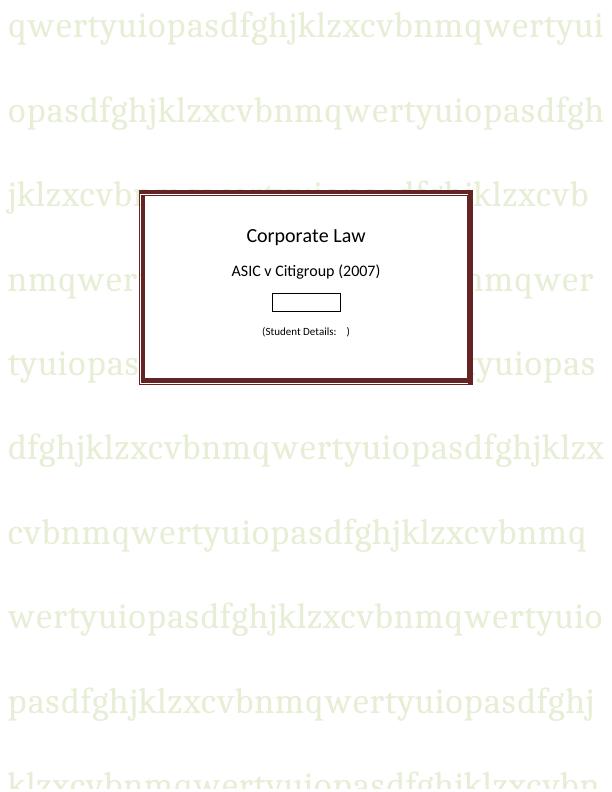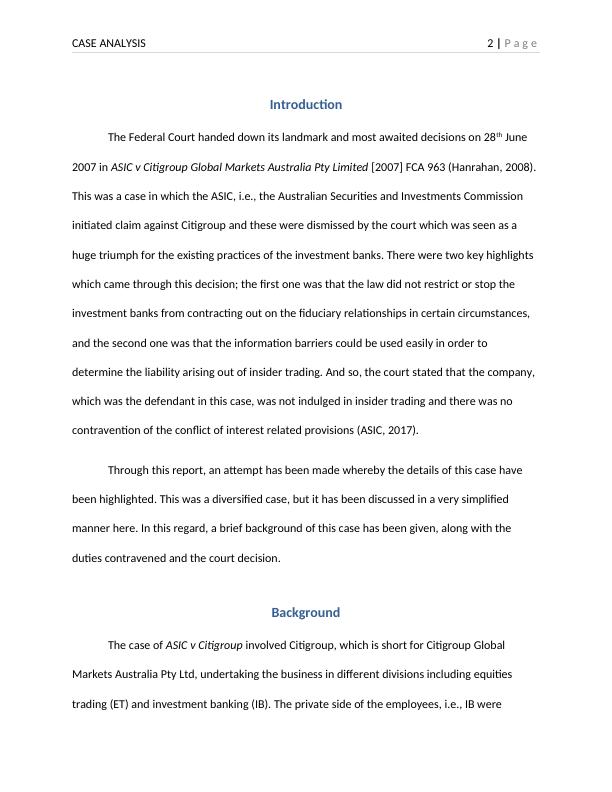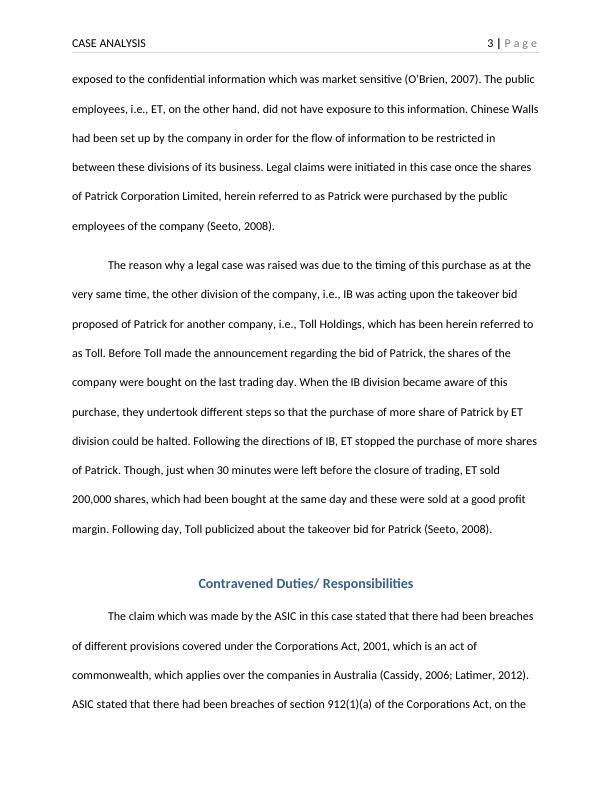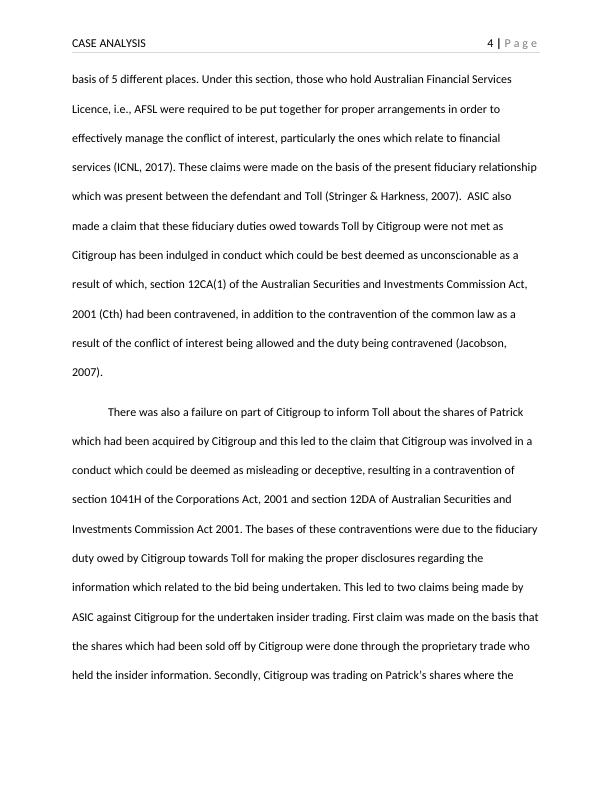Ask a question from expert
Corporate Law Assignment - ASIC v Citigroup Case Analysis
12 Pages2766 Words264 Views
Added on 2020-03-23
Corporate Law Assignment - ASIC v Citigroup Case Analysis
Added on 2020-03-23
BookmarkShareRelated Documents
qwertyuiopasdfghjklzxcvbnmqwertyuiopasdfghjklzxcvbnmqwertyuiopasdfghjklzxcvbnmqwertyuiopasdfghjklzxcvbnmqwertyuiopasdfghjklzxcvbnmqwertyuiopasdfghjklzxcvbnmqwertyuiopasdfghjklzxcvbnmqwertyuiopasdfghjklzxcvbnmqwertyuiopasdfghjklzxcvbnmqwertyuiopasdfghjklzxcvbnmqwertyuiopasdfghjklzxcvbnmqwertyuiopasdfghjklzxcvbnmqwertyuiopasdfghjklzxcvbnCorporate LawASIC v Citigroup (2007)(Student Details: )

CASE ANALYSIS 2 | P a g eIntroductionThe Federal Court handed down its landmark and most awaited decisions on 28th June 2007 in ASIC v Citigroup Global Markets Australia Pty Limited [2007] FCA 963 (Hanrahan, 2008). This was a case in which the ASIC, i.e., the Australian Securities and Investments Commission initiated claim against Citigroup and these were dismissed by the court which was seen as a huge triumph for the existing practices of the investment banks. There were two key highlights which came through this decision; the first one was that the law did not restrict or stop the investment banks from contracting out on the fiduciary relationships in certain circumstances, and the second one was that the information barriers could be used easily in order to determine the liability arising out of insider trading. And so, the court stated that the company, which was the defendant in this case, was not indulged in insider trading and there was no contravention of the conflict of interest related provisions (ASIC, 2017). Through this report, an attempt has been made whereby the details of this case have been highlighted. This was a diversified case, but it has been discussed in a very simplified manner here. In this regard, a brief background of this case has been given, along with the duties contravened and the court decision. BackgroundThe case of ASIC v Citigroup involved Citigroup, which is short for Citigroup Global Markets Australia Pty Ltd, undertaking the business in different divisions including equities trading (ET) and investment banking (IB). The private side of the employees, i.e., IB were

CASE ANALYSIS 3 | P a g eexposed to the confidential information which was market sensitive (O’Brien, 2007). The public employees, i.e., ET, on the other hand, did not have exposure to this information. Chinese Wallshad been set up by the company in order for the flow of information to be restricted in between these divisions of its business. Legal claims were initiated in this case once the shares of Patrick Corporation Limited, herein referred to as Patrick were purchased by the public employees of the company (Seeto, 2008).The reason why a legal case was raised was due to the timing of this purchase as at the very same time, the other division of the company, i.e., IB was acting upon the takeover bid proposed of Patrick for another company, i.e., Toll Holdings, which has been herein referred to as Toll. Before Toll made the announcement regarding the bid of Patrick, the shares of the company were bought on the last trading day. When the IB division became aware of this purchase, they undertook different steps so that the purchase of more share of Patrick by ET division could be halted. Following the directions of IB, ET stopped the purchase of more sharesof Patrick. Though, just when 30 minutes were left before the closure of trading, ET sold 200,000 shares, which had been bought at the same day and these were sold at a good profit margin. Following day, Toll publicized about the takeover bid for Patrick (Seeto, 2008). Contravened Duties/ ResponsibilitiesThe claim which was made by the ASIC in this case stated that there had been breaches of different provisions covered under the Corporations Act, 2001, which is an act of commonwealth, which applies over the companies in Australia (Cassidy, 2006; Latimer, 2012). ASIC stated that there had been breaches of section 912(1)(a) of the Corporations Act, on the

CASE ANALYSIS 4 | P a g ebasis of 5 different places. Under this section, those who hold Australian Financial Services Licence, i.e., AFSL were required to be put together for proper arrangements in order to effectively manage the conflict of interest, particularly the ones which relate to financial services (ICNL, 2017). These claims were made on the basis of the present fiduciary relationshipwhich was present between the defendant and Toll (Stringer & Harkness, 2007). ASIC also made a claim that these fiduciary duties owed towards Toll by Citigroup were not met as Citigroup has been indulged in conduct which could be best deemed as unconscionable as a result of which, section 12CA(1) of the Australian Securities and Investments Commission Act, 2001 (Cth) had been contravened, in addition to the contravention of the common law as a result of the conflict of interest being allowed and the duty being contravened (Jacobson, 2007). There was also a failure on part of Citigroup to inform Toll about the shares of Patrick which had been acquired by Citigroup and this led to the claim that Citigroup was involved in a conduct which could be deemed as misleading or deceptive, resulting in a contravention of section 1041H of the Corporations Act, 2001 and section 12DA of Australian Securities and Investments Commission Act 2001. The bases of these contraventions were due to the fiduciaryduty owed by Citigroup towards Toll for making the proper disclosures regarding the information which related to the bid being undertaken. This led to two claims being made by ASIC against Citigroup for the undertaken insider trading. First claim was made on the basis thatthe shares which had been sold off by Citigroup were done through the proprietary trade who held the insider information. Secondly, Citigroup was trading on Patrick’s shares where the

End of preview
Want to access all the pages? Upload your documents or become a member.
Related Documents
Business Law Assignment - Case Analysis ASIC v Citigroup Global Markets Australia Pty Ltdlg...
|11
|2857
|109
Group Assignment Nassar v Innovative Precasters Group Pty Ltd (2009) NSWSC 342 2017 (Student Details:) 07-Sep-17 Introductionlg...
|11
|2787
|226
Directors’ Duties, Corporation Act 2001 (Cth)lg...
|6
|1606
|451
The decision of the court: ASIC V SOUST [2010] FCA 68 Question & Answerlg...
|9
|2408
|340
HI6027 Assignment on Business & Corporations Lawlg...
|10
|2506
|115
Corporation Law ASIC Vs Adlerlg...
|9
|2469
|211